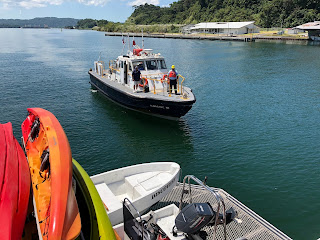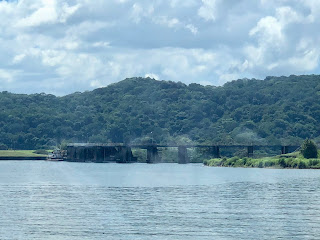Monday October 8
* * * * *
Official itinerary:
This morning, you'll visit the Agua Clara Visitor Center to get a unique panoramic glimpse of the Panama Canal. This observatory not only provides great views of the canal, but also history of its construction.
Later, you'll return to our ship for lunch onboard and some time for a short rest, or siesta. Your ship will continue your transit of the canal, as you pass through the Gatun Locks—the largest of the Panama Canal locks. The ship will begin its descent back to sea level here, a process that takes about two hours. You'll enjoy a Captain's Farewell Dinner onboard.
* * * * *
Slept quite well again on the ship (that’s what I decided to call it since I don’t want to call it vessel or boat). Again coffee or tea is available starting at 6:30 am and breakfast buffet is ready at 7 am. It looks like another glorious day.
We barely had started breakfast when somebody (probably Ian) made us aware that there was a crocodile swimming along. It was in the distance and I tried to take a photo but you probably can’t see it. Anyway, proof that they are in the lake.
At 8:45 am we are brought in the motorboats to the shore close to the lock. Actually it is a former yacht club. A small bus was waiting for us and took us to the Aqua Clara Visitor Center for us to have a good look at the new locks.
We even drive over one of the sliding gates to get there because the new bridge is not finished yet. Look right and then left.
VIDEO! (3:17)
We wander around to look at everything. We saw a movie about the building of the lock, at 10 it was in English. I also saw information about native animals we had seen.
At 10:30 we were in the bus again and right away saw coati on the road side. Ian took us to a former US military side in the Canal Zone. The bus meandered through the streets. He had lived there as a child because his father had been a civilian employee. He was dwelling in memories.
We drove again over the sliding gate and had a better look. Back at the old yacht club and back to our ship.
This is the entry to the new lock which we are NOT going to use for the final three stages down to the caribbean side of the isthmus.. Only for very large ships.
Lunch time. I am fascinated with the table-runners. I think we were served soup and salad. The food is most delicious. Buffet is only at breakfast time.
Around 1 pm the pilot comes on board and we start on the journey through the lock towards the Atlantic Ocean or Caribbean Sea. Either name seems to be used. Little ships like ours always go through the old locks.
When we approach the west lock we see that the ship before us is the US Bob Hope. How cool is that?
The Chagres River Dam, built to make the lake.
Sorry, we had to jump up during lunch whenever we saw something we where could take a closer look. Food was still very much enjoyed. You know us and salads.
There are three stages going down this time.
The first is 29 feet.
The second is 30 feet.
The third is a 26 feet drop.
The whole process takes quite a while. It might have been 2 pm by the time we were in the first lock. Since we are a small ship we have to share. Behind us is quite a big freighter and we keep saying “ please stop”. In the photos you can see clearly the “mules”(small electric tractors on rails) which steady the big ships. Several mules are used for each depending on their sizes. It was interesting to see the heavy metal ropes tightening left or right so the tight fitting ships don’t scratch the walls.
There was a lot to see besides creatures like the lapwing bird. Somebody asked what the bullseye was for and the goalposts. One is for the canal workers to practice accurate throwing of the ropes and the other high throwing.
Step by step we got closer to the Atlantic. If I did the math right Gatun Lake is 85 feet higher than the oceans. And then there is also always the consideration of the tides. Tidal highs and lows are about 14 feet each way and they are not the same on both oceans. I am so in awe about the whole thing. Those who had started the planning had a lot to figure out. No wonder the first (the French) attempt failed doing it. This was also due to the lack of sanitation and what havoc mosquitos can do. So many people died in the process.
Ugh, ugh, our ship had to share the lock with the large ship coming. Filling the locks must be math too. What will fit in where.
We all talked as if we where scared. Boy, if he can't brake in time we are smushed. But of course they know what they are doing and the "mules" on each side help the large ships.
 |
| (shared by Octavio) |
Ha-ha, I had to go to our cabin on the lower level at one point when the water was let down and suddenly it had got dark in the cabin.
Wow, that guy better hurry across the gates. They are about to open.
The third bridge over the canal. Not finished yet.
"Endstation" (end of the ship journey) in the town of Colon. We are docked in a yacht harbor. 5 pm and time for a little walk. Oh my, nice “little boats” here. Lots of nature around. Octavio and Ian explain.
A kind of weaver bird nest hanging from the palm tree.
This tree has what they call fake almonds. Can be eaten. People make nice jams with them.
 |
| (shared by Octavio) |
7 pm. The captain’s fairwell dinner. The appetizer is a most delicious ceviche.
Main course: as always fish for me, pistachio crusted chicken for James.
Dessert: a little tart, very lemony. EVERYTHING very delicious. Did I mention that coffee and tea was always available. Every lunch or dinner you could ask for two drinks including wine or beer as long as you asked before dessert. Otherwise you could run a tab.
We thanked the crew.
Time to pack the suitcases. Bummer.
Night night.




















































2 comments:
Funny they are called "mules". We used to see their flesh and bone predecessors in a little canal town in Indiana when we lived there.
That's why they are called mules. I ran boats for the Army there back in the 1970s. That "former yacht club" in an early picture was Dock 45, where we parked our boats at Ft. Davis. The tides are indeed different in each ocean, running about 18 feet on the Pacific side and about 18 inches on the Atlantic side.
Post a Comment